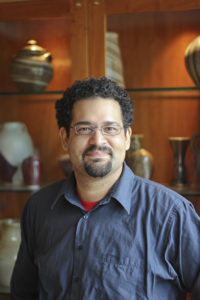 This post was written by Andreas Orphanides, who received a Focus Fellowship to attend the 2019 DLF Forum.
This post was written by Andreas Orphanides, who received a Focus Fellowship to attend the 2019 DLF Forum.
Andreas is Associate Head, User Experience at the NC State University Libraries. His work focuses on developing high-quality, thoughtfully designed solutions to support teaching, learning, and information discovery. He holds a Bachelor of Arts from Oberlin College, a Master of Science in Library Science from UNC-Chapel Hill, and a Master of Computer Science from NC State University. His professional interests include human factors, systems analysis, and design ethics.
Gone in 90 Seconds
Constrained writing is the practice of creative writing under artificial restrictions: you might challenge yourself not to use the letter e, or write a short story in under 100 words, or fit your thoughts into sonnet form. The idea is that writing under these constraints forces you to summon creative approaches to problem solving.
We don’t have a lot of equivalents to constrained writing in the academic realm. The closest we get is various sorts of structured presentations: 7×7 / Pecha Kucha, Battle Decks, lightning talks. The lightning talks at DLF are an unusually short 90 seconds — less than a third the length of the shortest talk I’d ever given previously.
How do you make a meaningful talk that fits into a minute and a half? The first step is to pick an idea. No, pick a smaller idea than that. OK, then you write it down. Now cut out half the words. OK, try saying all those words: can you do it in less than 90 seconds? Probably not. Cut some more words out. Is the idea still coherent? Barely. Good enough!
Then there’s the matter of the slides. It’s simply not possible to fit an idea that’s all that complex into 90 seconds. That said, for any complexity you do have, the visuals are going to have to do a lot of the heavy lifting. OK, so you’ve got some slides, with some words, and some lines, and a chart or two: they’re spartan, but functional. But if we’re going to get people’s attention over the span of our short talk (if they get distracted, they’ll miss it!) we’ve got to give a little life to the slides. The solution? Redraw them all using a magic marker. No problem.
Now it’s time to put it all together. You’ve got your slides: intended to be just kindergarten-looking enough to catch people’s attention. You’ve got your speaker notes: meticulously curated, parsimonious, perfectly timed to the slides. A few practice run-throughs. 87 seconds — that gives a 3% margin of error. It’ll have to do.
A few days later, you arrive at the venue. It’s your first DLF — it’s not your usual scene, and you’re not 100% sure how you ended up here, in fact. You feel like a lot is riding on this — you’ve got a special opportunity as a Forum Fellow to do this talk, and you do NOT want to screw it up. Anyway, it’ll be great. You’ve practiced. You’ve got presenter mode. What could go wrong?
One thing that could go wrong is that presenter mode isn’t available on the plenary podium. You’ll have to print notes. It’s an hour before your presentation. The organizers don’t have a printer available. Oh, and no one ever seems to be in the business center.
In a final act of creativity under constraint, you maybe trick the hotel’s airline check-in computer (“BOARDING PASSES ONLY,” scolds the sign) into printing out your slide notes.[1]
It’s 5 pm. It’s the plenary session and you’re waiting for your turn to talk to your 500 newest friends about a postage-stamp sized topic near and dear to your heart. You’re, what, fifth in the lightning talk queue, and somehow the talks ahead of you are both taking forever and going by so fast that you can’t keep up with what the presenters are saying. And then it’s your turn.
At last, the podium. Time becomes an abstraction; reality a haze. It just happens: squint at the notes, say the words, click the slides at the right time. Pretend to look at the audience every now and then. Somehow avoid screwing up, for the most part. You wrap up just before the unceremonious interruption of the buzzer. In a heady daze, you stumble back to your seat and try (and fail) to absorb the rest of the lightning talks.
Afterwards, there’s some flattering tweets, some compliments about your amazing marker-scribbling skills, some heavy hors d’oeuvres. In the final assessment, you feel like you acquitted yourself well. And then you sleep for 14 hours.
Authors practice constrained writing to inspire creativity. DLF’s 90-second lightning talks, precisely because of their absurd brevity, allow (and require) participants to pour a lot of creativity into a tiny package. Writing and delivering a lightning talk — and seeing the other great talks in the lightning talk session (I swear, I kind of remember some of them!) — was a great enhancement to my first DLF experience. We don’t get a lot of opportunities to undertake constrained writing in our line of work. I encourage you to try it.
[1] This never happened, I wasn’t there, plausible deniability, etc.
